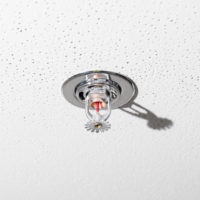Indoor Sprinklers: They’re Not Just for Hotels and Commercial Buildings

Smoke alarms save lives by alerting you to the presence of a fire and the need to grab the kids and the pets and get out of the house. If the fire is small enough, you might have time to put it out safely with a handy fire extinguisher (You do keep fire extinguishers handy, right? They can save lives and property and are probably required in your homeowner’s insurance policy). So you’ve got working smoke alarms and fire extinguishers, and an evacuation plan that the whole family has been drilled on. At least you’ll be safe, even if heaven forbid a fire destroys your home and all your belongings. If only there were something that could save not only your life but also your home from destruction in a fire.
Home fire sprinklers do more than just passively detect a fire. They actively put it out. These devices can save your life and your home. While sprinklers spring into action right away after detecting a fire, firefighters can take about ten minutes to reach your house and start fighting the fire. That’s more than enough time for a fire to take lives and spread to consume the entire house.
The National Fire Protection Association reports an 81% lower fatality rate in homes with fire sprinklers (and an 80% drop in average firefighter injury rate as well). Importantly, sprinklers contain the fire to the room of origin in almost every house fire. This means enhanced safety for family members as well as much less property damage. The average property damage in a sprinklered fire is $2,166, compared to $45,019 of damage in the average unsprinklered fire. You’ll likely also save on your homeowner’s insurance as well.
Won’t sprinklers ruin my home?
If you are worried about the water damage to your home and belongings caused by a sprinkler, put that worry into perspective. For one thing, cleaning up water damage is less costly than repairing fire damage. For another, sprinklers disperse water at about 20 gallons per minute, using up about 340 gallons to suppress a fire. Firefighters, on the other hand, put nearly 3,000 gallons of water into the home to fight a fire, with high-pressure hoses that cause damage from the force of the water alone. And remember that sprinklers most often will only go off in the room of the fire’s origin, leaving other rooms untouched. A fire that spreads will do much more damage, even if only smoke damage, as well as potentially turn deadly.
A concern lodged by skeptics is that the sprinklers may go off when there is not a fire that needs to be spinklered, causing water damage that wouldn’t otherwise occur. It’s important to understand that unlike smoke detectors, fire sprinklers are heat-activated. So your kitchen mishaps won’t set off the sprinklers unless there is a serious blaze, and then you’ll be glad they did.
So why doesn’t my new home have sprinklers?
As far back as 2008, the International Code Council tried to get a requirement for sprinklers to be installed in all new homes, but the homebuilders rebelled, and their lobbying killed proposed measures that had been introduced in 27 states. To-date, only California and Maryland appear to require sprinklers as part of all new home construction. Massachusetts and Nevada have partial mandates that may require sprinklers depending on the size of home being built.
Even if sprinklers are not required in your state or city, they are still well worth considering. According to the Home Fire Sprinkler Coalition, installing home fire sprinklers adds about $1.35 per square foot in new home construction costs, although prices vary and may be under a dollar per square foot in some localities. If you’re wondering about the cost to retrofit an existing home with fire sprinklers, the cost depends on a number of factors, including the age of the home, how it was built, and the existing water supply. By utilizing closet space and flexible piping, contractors can minimize cost as well as improve the resale value of the home rather than damage it. Retrofitting should be accomplished by qualified contractors who perform the work in compliance with the NFPA 13D standard.
Adding sprinklers potentially adds more pipes that could freeze and burst and more joints that could leak. Getting the job done right the first time should help avoid or minimize such problems, as well as replacing sprinkler heads as needed. With quality materials, this may never need to be done.



